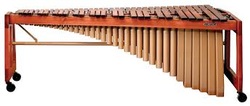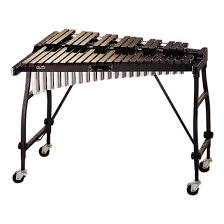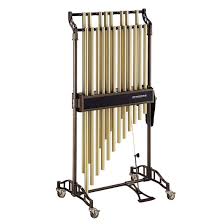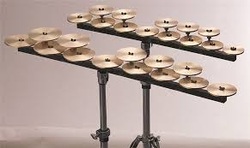The family of mallet percussion is a fascinating one to explore. These are some of the oldest musical instruments invented, and probably the first pitched instruments created by man. Historians have dated the first fully developed Xylophone to 3500 B.C. Different versions of the primitive Xylophone began to appear in Africa and the Orient in the 14th century. In Africa the instrument transformed into the "Marimba". African slaves introduced the African Marimba to Latin America during the years of the slave trade. In Europe, Mallet Percussion instruments were first introduced to European orchestras around 1874.
These are musical instruments of simple, elegant design. Ancient people in Asia and Africa were the first to construct basic versions of these instruments. Blocks of carved hardwood were suspended over a box-like resonator, which produced a beautiful soft sound. In Indonesia various mallet instruments were developed with metal. Today's modern models still employ the basics of this original design. Tuned bars of wood, metal or synthetics are strung over a frame. The resonator is usually a measured tube, sealed on the bottom. This enclosed chamber provides a natural amplification for each bar. The bars are often tuned chromatically, and arranged like the keys of a piano.
These are musical instruments of simple, elegant design. Ancient people in Asia and Africa were the first to construct basic versions of these instruments. Blocks of carved hardwood were suspended over a box-like resonator, which produced a beautiful soft sound. In Indonesia various mallet instruments were developed with metal. Today's modern models still employ the basics of this original design. Tuned bars of wood, metal or synthetics are strung over a frame. The resonator is usually a measured tube, sealed on the bottom. This enclosed chamber provides a natural amplification for each bar. The bars are often tuned chromatically, and arranged like the keys of a piano.

MARIMBA bars are made of wood (or synthetic materials). Rosewood is preferred for concert playing, but synthetic bars preferred for marching band and other outdoor use because they are more durable and less susceptible to pitch change due to weather. The bars are wider and longer at the lowest pitched notes, and gradually get narrower and shorter as the notes get higher. During the tuning , wood is taken from the middle underside of the bar to lower the pitch. Because of this, the bars are also thinner in the lowest pitch register and thicker in the highest pitch register.
In Africa, most marimbas are made by local artisans from locally available materials.
When playing the marimba it is preferred to strike the bar in the center for the fullest, most articulate tone, while striking (the accidental keys) on the edge produces a fine tone, while allowing the player to increase his speed. Playing on the node (the location where the string passes through the bars) is sonically very weak, so it is only used when the player or composer is looking for that particular muted sound.
African marimba music sounds unfamiliar to North American audiences because most of the marimba music played in the Western Hemisphere has been classical and Latin American folk. However, marimbas originated in Africa hundreds of years ago and were imported to South America in the sixteenth century. The original African sounds were incorporated into and changed by the music of the local American cultures
Range There is no standard range of the marimba, but the most common ranges are: The marimba is a non-transposing instrument.
3 octave (C4-C7) 3.5 octave (F3-C7) 4 octave (C3-C7)
4.3 octave (A2 to C7) this is probably the most common marimba size
4.5 octave (F2 to C7)
4.6 octave (E2 to C7) one note lower than the 4.5 octave marimba, this is useful for playing guitar literature.
5 octave (C2 to C7)
The range of the marimba has been gradually expanding, with companies adding notes up to F above the normal C7 on some 5.5 octave instruments, or adding notes lower than the low C on the 5 octave C2 (Adding lower notes is somewhat impractical because as the bars become bigger and the resonators become longer, two issues become important. First, the longer resonators present present a difficult design problem involving the necessity of constructing a taller instrument and second, the bars become very thin).
Resonators
Part of the key to the marimbas rich sound is its resonators. These are tubes that hang below each bar. The length varies according to the frequency that the bar produces. Vibrations from the bars resonate as they pass through the tubes, which amplify the tone in a manner very similar to the way in which the body of a guitar or cello would. In Central America, a hole is often carved into the bottom of each resonator and then covered with thin sheep skin to add a characteristic "buzzing" or "rattling" sound known as charleo
In Africa, most marimbas are made by local artisans from locally available materials.
When playing the marimba it is preferred to strike the bar in the center for the fullest, most articulate tone, while striking (the accidental keys) on the edge produces a fine tone, while allowing the player to increase his speed. Playing on the node (the location where the string passes through the bars) is sonically very weak, so it is only used when the player or composer is looking for that particular muted sound.
African marimba music sounds unfamiliar to North American audiences because most of the marimba music played in the Western Hemisphere has been classical and Latin American folk. However, marimbas originated in Africa hundreds of years ago and were imported to South America in the sixteenth century. The original African sounds were incorporated into and changed by the music of the local American cultures
Range There is no standard range of the marimba, but the most common ranges are: The marimba is a non-transposing instrument.
3 octave (C4-C7) 3.5 octave (F3-C7) 4 octave (C3-C7)
4.3 octave (A2 to C7) this is probably the most common marimba size
4.5 octave (F2 to C7)
4.6 octave (E2 to C7) one note lower than the 4.5 octave marimba, this is useful for playing guitar literature.
5 octave (C2 to C7)
The range of the marimba has been gradually expanding, with companies adding notes up to F above the normal C7 on some 5.5 octave instruments, or adding notes lower than the low C on the 5 octave C2 (Adding lower notes is somewhat impractical because as the bars become bigger and the resonators become longer, two issues become important. First, the longer resonators present present a difficult design problem involving the necessity of constructing a taller instrument and second, the bars become very thin).
Resonators
Part of the key to the marimbas rich sound is its resonators. These are tubes that hang below each bar. The length varies according to the frequency that the bar produces. Vibrations from the bars resonate as they pass through the tubes, which amplify the tone in a manner very similar to the way in which the body of a guitar or cello would. In Central America, a hole is often carved into the bottom of each resonator and then covered with thin sheep skin to add a characteristic "buzzing" or "rattling" sound known as charleo

XYLOPHONE (from the Greek - xylon, "wood" - phone, "voice", meaning "wooden sound") The xylophone is a historical instrument that originated independently in Africa and Asia.
The earliest evidence of a xylophone is from the 9th Century in Asia according to theVienna Library, and there is a model of a similar hanging wood instrument, dated to ca. 2000 BC in China. The original instrument consisted of wooden bars seated on a series of hollow gourds, with the gourds generating the resonating notes that are produced on modern instruments by metal tubes. Tuning the bars was always a difficult procedure. Old methods consisted of arranging the bars on tied bundles of straw, and, as still practiced today, placing the bars adjacent to each other in a ladder-like layout. The earliest historical reference to a xylophone came in the 14th century. The first use of a European-derived orchestral xylophone was by Saint Saenes in 1847.
The xylophone is related to the marimba, and a precursor to the vibraphone, which was developed in the 1920s.
The xylophone was frequently used by early jazz bands in the 1920s and 1930s. It was also a very popular instrument in Vaudville.
Range There is no standard range of the xylophone. They can be as small as 2 1/2 octaves but a concert xylophone is most commonly 3.5 octaves (F4-C8) or more rarely 4 octaves (C4-C8).
Concert Xylophones have resonators below the bars to enhance the tone and sustain. The xylophone is a transposing instrument sounding one octave higher than written.
The earliest evidence of a xylophone is from the 9th Century in Asia according to theVienna Library, and there is a model of a similar hanging wood instrument, dated to ca. 2000 BC in China. The original instrument consisted of wooden bars seated on a series of hollow gourds, with the gourds generating the resonating notes that are produced on modern instruments by metal tubes. Tuning the bars was always a difficult procedure. Old methods consisted of arranging the bars on tied bundles of straw, and, as still practiced today, placing the bars adjacent to each other in a ladder-like layout. The earliest historical reference to a xylophone came in the 14th century. The first use of a European-derived orchestral xylophone was by Saint Saenes in 1847.
The xylophone is related to the marimba, and a precursor to the vibraphone, which was developed in the 1920s.
The xylophone was frequently used by early jazz bands in the 1920s and 1930s. It was also a very popular instrument in Vaudville.
Range There is no standard range of the xylophone. They can be as small as 2 1/2 octaves but a concert xylophone is most commonly 3.5 octaves (F4-C8) or more rarely 4 octaves (C4-C8).
Concert Xylophones have resonators below the bars to enhance the tone and sustain. The xylophone is a transposing instrument sounding one octave higher than written.

VIBRAPHONE (sometimes called the vibraharp or simply the vibes)
is similar in appearance to the marimba & xylophone although the vibraphone uses aluminum alloy bars. Each bar is paired with a resonator tube having a motor-driven “fan” which produces a vibrato effect while spinning. The vibraphone also has a sustain pedal. When the pedal is up, the bars are all damped and the sound of each bar is quite short; with the pedal down, they will sound for several seconds.
Range There is no standard range of vibraphone. They can be as small as 2 1/2 octaves but typical vibraphone is 3 octaves (F3-F6) with 3.5 & 4 octaves becoming more common.
The Vibraphone is a non transposing instrument.
is similar in appearance to the marimba & xylophone although the vibraphone uses aluminum alloy bars. Each bar is paired with a resonator tube having a motor-driven “fan” which produces a vibrato effect while spinning. The vibraphone also has a sustain pedal. When the pedal is up, the bars are all damped and the sound of each bar is quite short; with the pedal down, they will sound for several seconds.
Range There is no standard range of vibraphone. They can be as small as 2 1/2 octaves but typical vibraphone is 3 octaves (F3-F6) with 3.5 & 4 octaves becoming more common.
The Vibraphone is a non transposing instrument.

ORCHESTRA BELLS (often called glockenspiel, or bell lyre) consist of metal bars.
Range The standard range is 2.5 octaves (G5 to C8).
The bells are a transposing instrument sounding two octave higher than written, and seldom have resonators.
Range The standard range is 2.5 octaves (G5 to C8).
The bells are a transposing instrument sounding two octave higher than written, and seldom have resonators.

CHIMES (also called Tubular Bells)
Range The standard chime range is 1.5 octaves (C5-F6)
The chimes are a a non transposing instrument.
Range The standard chime range is 1.5 octaves (C5-F6)
The chimes are a a non transposing instrument.

CROTALES (sometimes called antique cymbals) are small bronze and brass alloy disks.
Range The standard crotale range is 2 octaves (usually available in one octave sets C6 to C7 or C7 to C8)
The crotales are a transposing instrument sounding two octave higher than written.
One of the earliest uses of crotales in the orchestral repertoire is found in Claude Debussy’s “Prelude to the afternoon of a Faun”.Crotales are also found in prehistory. The National Museum of Ireland has several examples on display dating from the late Bronze Age (1200-800BC) which were found in a hoard alongside various brass wind instruments.
Range The standard crotale range is 2 octaves (usually available in one octave sets C6 to C7 or C7 to C8)
The crotales are a transposing instrument sounding two octave higher than written.
One of the earliest uses of crotales in the orchestral repertoire is found in Claude Debussy’s “Prelude to the afternoon of a Faun”.Crotales are also found in prehistory. The National Museum of Ireland has several examples on display dating from the late Bronze Age (1200-800BC) which were found in a hoard alongside various brass wind instruments.
